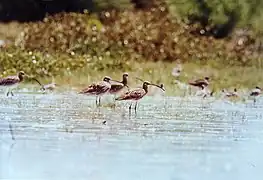Far Eastern curlew
The Far Eastern curlew (Numenius madagascariensis) is a large shorebird most similar in appearance to the long-billed curlew, but slightly larger. It is mostly brown in color, differentiated from other curlews by its plain, unpatterned brown underwing. It is not only the largest curlew but probably the world's largest sandpiper, at 60–66 cm (24–26 in) in length and 110 cm (43 in) across the wings.[3] The body is reportedly 565–1,150 g (1.246–2.535 lb), which may be equaled by the Eurasian curlew.[4] The extremely long bill, at 12.8–20.1 cm (5.0–7.9 in) in length, rivals the bill size of the closely related long-billed curlew as the longest bill for a sandpiper.[3]
| Far Eastern curlew | |
|---|---|
 | |
| Scientific classification | |
| Domain: | Eukaryota |
| Kingdom: | Animalia |
| Phylum: | Chordata |
| Clade: | Dinosauria |
| Class: | Aves |
| Order: | Charadriiformes |
| Family: | Scolopacidae |
| Genus: | Numenius |
| Species: | N. madagascariensis |
| Binomial name | |
| Numenius madagascariensis (Linnaeus, 1766) | |
| Synonyms[2] | |
|
Scolopax madagascariensis Linnaeus, 1766 | |
Distribution and habitat


The Far Eastern curlew spends its breeding season in northeastern Asia, including Siberia to Kamchatka, and Mongolia. Its breeding habitat is composed of marshy and swampy wetlands and lakeshores. Most individuals winter in coastal Australia, with a few heading to South Korea, Thailand, Philippines and New Zealand, where they stay at estuaries, beaches, and salt marshes. During its migration the Far Eastern curlew commonly passes the Yellow Sea.
It uses its long, decurved bill to probe for invertebrates in the mud. It may feed in solitary but it generally congregates in large flocks to migrate or roost. Its call is a sharp, clear whistle, cuuue-reee, often repeated.
As of 2006, there are an estimated 38,000 individuals in the world. Formerly classified as least concern by IUCN, it was found to have been rarer than previously believed and thus its status was updated to "vulnerable" in the 2010 IUCN red list of threatened species.[1]
In Australia its status under the Environment Protection and Biodiversity Conservation Act is "critically endangered".[5]
Taxonomy
In 1760 the French zoologist Mathurin Jacques Brisson included a description of the Far Eastern curlew in his Ornithologie based on a specimen. He used the French name Le courly de Madagascar and the Latin Numenius madagascariensis.[6] Although Brisson coined Latin names, these do not conform to the binomial system and are not recognised by the International Commission on Zoological Nomenclature.[7] When in 1766 the Swedish naturalist Carl Linnaeus updated his Systema Naturae for the twelfth edition, he added 240 species that had been previously described by Brisson.[7] One of these was the far eastern curlew, for which he coined the binomial name Scolopax madagascariensis.[8]
References
- BirdLife International (2017) [amended version of 2016 assessment]. "Numenius madagascariensis". IUCN Red List of Threatened Species. 2017: e.T22693199A118601473. doi:10.2305/IUCN.UK.2017-3.RLTS.T22693199A118601473.en. Retrieved 8 December 2021.
- Australian Biological Resources Study (12 February 2010). "Species Numenius (Numenius) madagascariensis (Linnaeus, 1766)". Australian Faunal Directory. Canberra, Australian Capital Territory: Department of the Environment, Water, Heritage and the Arts, Australian Government. Retrieved 13 December 2018.
- Marchant, John; Hayman, Peter; Prater, Tony (1986). Shorebirds. London, UK: Christopher Helm. pp. 320–321. ISBN 978-0-7136-3509-6.
- CRC Handbook of Avian Body Masses by John B. Dunning Jr. (Editor). CRC Press (1992), ISBN 978-0-8493-4258-5.
- Department of the Environment, Numenius madagascariensis — Eastern Curlew, accessed 30 May 2015 http://www.environment.gov.au/cgi-bin/sprat/public/publicspecies.pl?taxon_id=847
- Brisson, Mathurin Jacques (1760). Ornithologie, ou, Méthode contenant la division des oiseaux en ordres, sections, genres, especes & leurs variétés (in French and Latin). Vol. 5. Paris: Jean-Baptiste Bauche. pp. 321–24, Plate 28. The two stars (**) at the start of the section indicates that Brisson based his description on the examination of a specimen.
- Allen, J.A. (1910). "Collation of Brisson's genera of birds with those of Linnaeus". Bulletin of the American Museum of Natural History. 28: 317–335. hdl:2246/678.
- Linnaeus, Carl (1766). Systema naturae : per regna tria natura, secundum classes, ordines, genera, species, cum characteribus, differentiis, synonymis, locis (in Latin). Vol. 1, Part 1 (12th ed.). Holmiae (Stockholm): Laurentii Salvii. p. 242.
Further reading
- O'Brien, Michael et al. (2006). The Shorebird Guide. New York: Houghton Mifflin. ISBN 0-618-43294-9
- A Yellow Sea species account
